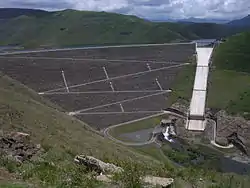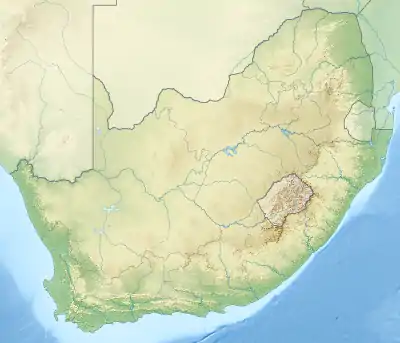Senqunyane River
The Senqunyane River is a river of central Lesotho. The name means Little Orange River in Sotho. The river rises in the Maluti Mountains in northwest Lesotho, and flows southwards and then westwards for 120 kilometres before joining the Senqu River (Orange River)[1] in the southwest.[2]
| Senqunyane River | |
|---|---|
 The Mohale Dam impounding the Senqunyane River | |
 Location of the Senqunyane River's mouth  Senqunyane River (South Africa) | |
| Location | |
| Country | Lesotho |
| Physical characteristics | |
| Source | Maluti Mountains |
| • elevation | 2,850 m (9,350 ft) |
| Mouth | Senqu River (Orange River) |
• coordinates | 30°1′59″S 28°10′26″E |
• elevation | 1,515 m (4,970 ft) |
| Length | 120 km (75 mi) |
| Basin features | |
| Tributaries | |
| • right | Bokong River, Jordane River, Likalaneng River |
The source of the Senqunyane is the meeting point of three districts: Thaba-Tseka District, Berea District and Leribe District. It forms the border between Thaba-Tseka District and first Berea and then Maseru District for much of its length.
Tributaries include the Bokong River,[3] as well as the Jordane River and Likalaneng River, which join the Senqunyane shortly before the Mohale Dam.[4]:33
The Mohale Dam, opened in 2003, is part of the Lesotho Highlands Water Project, diverting water to the Katse Dam and hence to the Gauteng region in South Africa, including the cities of Johannesburg and Pretoria.
The river is home to the rare Rock-catfish ("Austroglanis sclateri").[5] The Semongkoaneng Waterfall acts as a migration barrier separating distinct fish communities.[5]
The Senqunyane Valley is the site of a number of archaeological and rock art sites.[6] The valley was first inhabited in the Middle Stone Age.[6]
The sandstone gorge with steep cliffs poses a problem to access. A notable bridge build in 2011 crosses the river near its confluence with the Orange River.[7][8]
See also
- Mohale Dam — on the Senqunyane River.
- Lesotho Highlands Water Project
References
- The Orange River, Delineating the Border between South Africa and Namibia
- Fitzpatrick, M., Blond, B., Pitcher, G., Richmond, S., and Warren, M. (2004) South Africa, Lesotho and Swaziland. Footscray, VIC: Lonely Planet
- van Vuuren, Sanet Janse; Walt, Nicolene van der; Swanepoel, Annelie (2007). "Changes in algal composition and environmental variables in the high-altitude Mohale Dam — an important water supply reservoir to South Africa". African Journal of Aquatic Science. 32 (3): 265–274. doi:10.2989/ajas.2007.32.3.6.305.
- Consortium, Lahmeyer McDonald; Consortium, Olivier Shand (1986). Lesotho Highlands Water Project: H14-19. Kingdom of Lesotho, Ministry of Water, Energy and Mining.CS1 maint: ref=harv (link)
- BH, Niehaus (1996). "An ecological investigation of the aquatic vertebrates below the proposed Mohale Dam wall in the Senqunyane River, Lesotho, with emphasis on the rock catfish (Austroglanis sclateri), Masters thesis". Retrieved 4 March 2017. Cite journal requires
|journal=(help) - Bousman, Britt (1988). "Prehistoric Settlement Patterns in the Senqunyane Valley, Lesotho". The South African Archaeological Bulletin. 43 (147): 33–37. doi:10.2307/3887611. JSTOR 3887611.
- Boshoff, Jody (1 February 1977). "Five new bridges to increase access to southeastern Lesotho : market contribution". Civil Engineering = Siviele Ingenieurswese. 19 (2). ISSN 1021-2000.
- Africon Environment and Sustainability (2006). Senqu and Senqunyane River Bridges and Connecting Road: Environmental Impact Assessment Report. AGRIS: International Information System for the Agricultural Science and Technology. The World Bank. ISBN 9789589774649. Retrieved 4 March 2017.